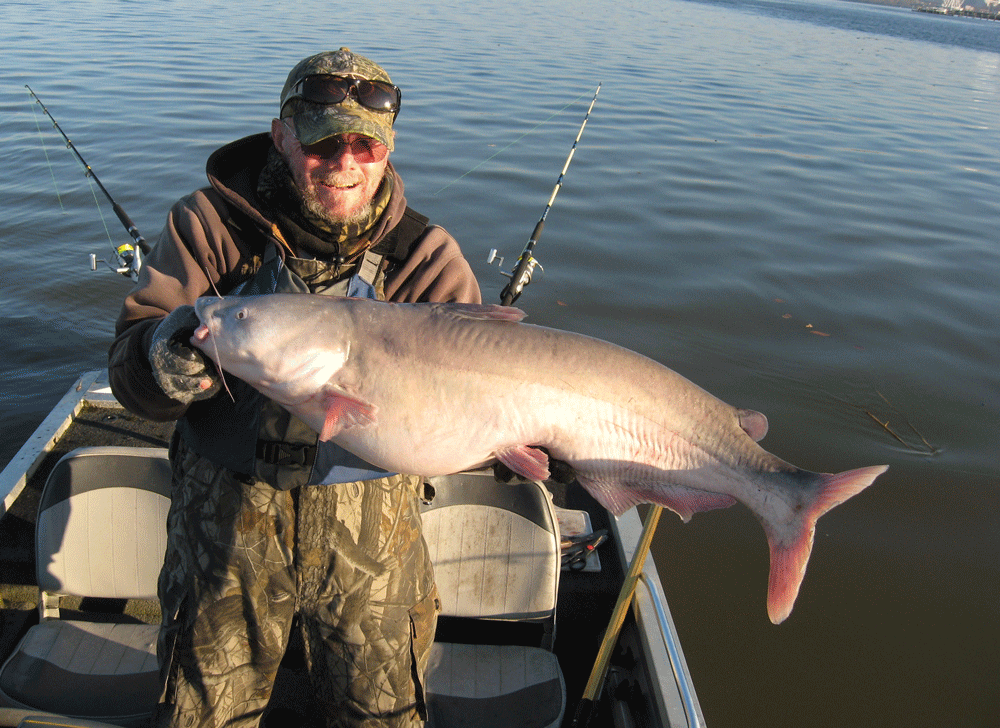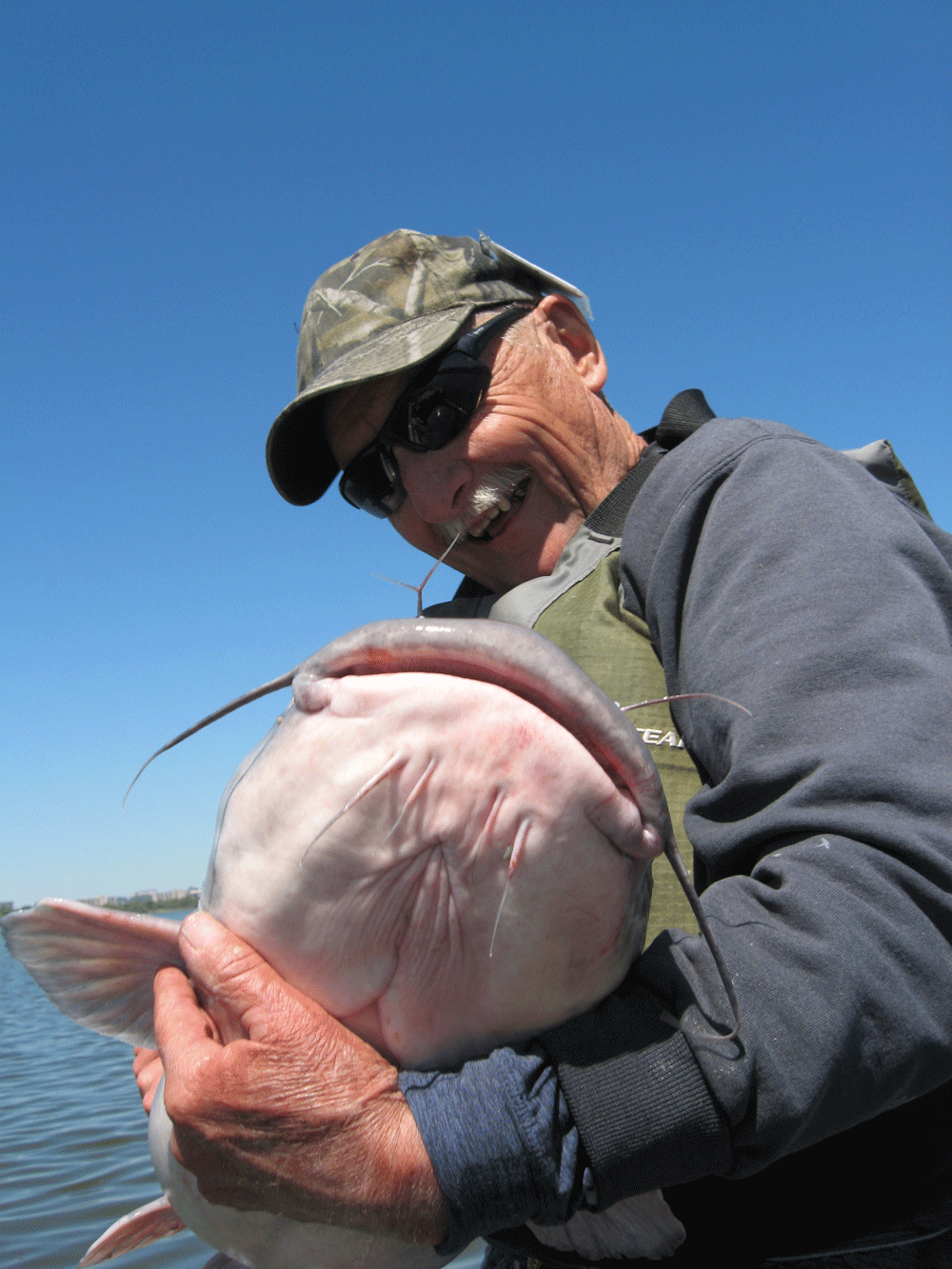Giant blue catfish swarm the tidal rivers off the Chesapeake Bay, and tempting anglers across the Mid-Atlantic region. Striped bass, bull reds, swordfish, largemouth and smallmouth bass, and numerous other species will be doing their best to fatten up for winter this month, giving anglers a number of possibilities to pick and choose from. Still others may travel, and pursue anything from sailfish in Florida to salmon runs in the Great Lakes tributaries. Me? I’m not going anywhere too far—because this is one of the best times to catch big blue catfish from the Potomac and James Rivers in Maryland and Virginia.

Gigantic Blue Catfish Fishing Tackle
Both of these rivers have storied fisheries on giant catfish. The Potomac has given up fish in the mid 80-pound range and the James tops out with fish at just over 100-pounds. Although the amount of cats exceeding the 50-pound benchmark has dropped in recent years, there are still lots of fish from 20 to 50 pounds and still viable shots at fish much larger. A fisherman can choose to play the numbers game with fish from 10 to 20 pounds, or seek a washtub-sized blue cat.
Throughout many areas of the tidal Potomac and the James, you can spend many hours catching “little” cats, that is fish that run from five to almost 20 pounds, and either keep some for a meal or do the total catch and release gig. Maryland currently views the blue catfish as an invasive species and there are no limits in size or creel on them. Virginia has a one fish per angler, per day, exceeding 32 inches limit. Both fisheries are being impacted by high numbers of smaller, harvestable fish and some commercial outlets are taking advantage of this abundance. However, the majority of the blue catfish anglers in the region do it for the sport and hopes of a giant.
You can get away with scaled down tackle when going for the more abundant, smaller blues. Medium spinning gear and six to seven foot rods that will handle 20-pound test braid or 17-pound test mono works well. In-line weights from three to five ounces and 5/0 circle hooks of your choice help to complete a Carolina rig with leaders from 12 to 16 inches long. Simply snell the hook, tie the leader off to a 50-pound test swivel, and run the in-line weight on the mainline with either a plastic bead or a quarter-inch piece of rubber tubing, to cushion the knot on the mainline.
Some cat-men like to use a three-way swivel to place their baits various distances from the bottom with different lengths to a five-ounce bell or sinker. In strong, tidal currents, the leader to your bait should be no longer than 16 inches as many cut baits tend to swirl around in the current, making it hard for cats to home in.
Bait for Blue Cats
Bait options vary, but cut gizzard shad seems to be the golden standard across the Mid-Atlantic region. However, cut sunfish or crappie or even store-bought species like mackerel and herring offer some options when colder weather makes netting shad tough. Cut or steak the fish into two-by-two inch chunks, and leave plenty of the hook’s point exposed when baiting up. Long, lengthy casts are not needed if you anchor over active fish, and hooksets are assured when aggressive fish peg the rod over from the holder. Set the drags tight, but not so much so that a 30 pounder can’t pull the drag.
If weeding through hordes of smaller cats for fast action as you await the big-boy to bite is not your game, then you’ll have to fish bigger gear and bigger baits. Most cat-fishers prefer 600 or 700 class baitcasting gear and seven-foot fiberglass rods that can “load up” in the rod holder and absorb the surges of bigger fish. Additionally, most like quality monofilament as the mainline in the 30 to 50 pound class range. Berkeley Big Game and Ande lines are good choices for this. Larger spinning options also work well as long as your reel of choice has a smooth, steady drag system.
With the quest for bigger cats also comes larger hooks and heavier weights. The flat “no roll” in-line weights in six or eight ounces work well, and hooks should be upgraded to 6/0 or 8/0 circles. Leaders still run from 12 to 16 inches to the swivel, but is also upgraded to a 100-pound test link. Cut baits are sliced larger and chunked portions of fresh baitfish are hooked on the top dorsal end, leaving plenty of the hook’s point exposure to allow the circle hook to do its job.
Hotspots and Tides for Blue Cats
Tidal blue cats are structure oriented and they are traditionally found along channel edges, channel bends, scour holes, in rises or dips in bottom terrain, and also in shallow, dark-bottomed flats and bays that heat up from the sun on a chilly fall day. Depths can vary greatly and they can be as deep as 50 feet or as shallow as five. Protruding points and bridges also attract them, and often there are a variety of different sized cats within a small area. Sometimes, you’ll hook a 40 to 50 pounder on the light gear and may have to make a decision to follow, or not to follow, a big cat when it shows up. Then on the other hand, you could be sitting on the edge of a prime channel drop, armed with heavy gear for heavyweight catties, and it’s nothing but missed strikes and occasional hookups from pesky five to 10 pounders that just can’t quite get that 8/0 circle hook in their mouths. It pays to keep one smaller 20-pound class outfit handy, if you want to have plenty of fish-fighting fun on any given trip.

Most experienced blue catfish anglers agree that a moving tide stirs feeding activity and triggers a bite. Many Potomac and James River catters prefer the first few hours of the outgoing or incoming flows, with very little activity on the slack tides. However, moving water is good and some location shine on the incoming, while others are productive on the outgoing. It all depends on the dynamics of the location. Mark fish with your unit then anchor just up-current from them, and place baits to draw them to you.
A word about cold fronts: blue catfish are among the most sensitive fish out there when it comes to incoming colder weather and barometric changes—they just shut down. However, fishing six to 12 hours ahead of a big blow can get you in on some crazy action.
These blue cats, especially the big ones, feed well into the winter months throughout the Mid-Atlantic region, and right now is a prime time to catch 50-plus-pound fish. This fall and winter give it a shot, and see if you can’t get your own river monster on the line.
-by Jim Gronaw, author of The Gospel According to Bluegills